The Most Effective Sorts Of Web Style to Improve Individual Experience and Engagement
In the ever-evolving landscape of digital communication, the efficiency of Web design dramatically impacts customer experience and involvement. Various design techniques, such as minimalist, responsive, and interactive layouts, each offer special advantages that can cater to diverse customer requirements.
Minimal Web Style
As electronic landscapes come to be increasingly cluttered, minimal website design has become an effective strategy to improving customer experience. This design approach prioritizes simplicity, concentrating on crucial components while eliminating unnecessary interruptions. By utilizing adequate white area, simple navigation, and a minimal color scheme, minimalist layout fosters clarity and guides individual focus to key content.
The core concept of minimal website design is to create a smooth communication for individuals. By minimizing cognitive load, individuals can promptly realize details without really feeling bewildered. This direct technique not just enhances functionality but additionally motivates interaction, as site visitors are most likely to discover a site that is aesthetically enticing and simple to navigate.
Furthermore, minimalist style commonly highlights typography and images, making use of these components strategically to communicate messages properly. In significance, minimal Web style is not just a pattern; it is a thoughtful methodology that acknowledges the relevance of user-centered layout.
Responsive Website Design
In today's varied digital environment, receptive Web layout has become necessary for creating a smooth user experience across a plethora of gadgets. As users access internet sites on smart devices, laptops, desktop computers, and tablets, the capability of a web site to adapt its layout and content to different screen sizes and resolutions is crucial.
Receptive Web design employs adaptable grids, photos, and CSS media queries to guarantee that Web content is provided efficiently, no matter the device made use of. This strategy not just boosts the visual allure of a site however likewise considerably boosts usability. Users are most likely to engage with a site that provides a regular experience, as it gets rid of the disappointment of having to focus or scroll exceedingly.
By adopting responsive design, companies can boost their presence and get to a wider target market. In recap, responsive Web layout is a fundamental practice that boosts individual experience, interaction, and overall fulfillment.
Interactive Website Design
Receptive Web layout prepares for improving customer experience, yet interactive website design takes this an action better by engaging users in a more dynamic way - Aligned Position Web Design. By integrating aspects such as animations, clickable prototypes, and real-time comments, interactive Web style mesmerizes individuals, attracting them into a richer surfing experience
This approach not only fosters engagement yet likewise encourages individuals to check out material actively instead of passively consuming it. Strategies such as gamification, where users make rewards for finishing jobs, can dramatically boost the time invested in a website and improve general fulfillment. Interactive attributes can simplify intricate info, making it much more absorbable and enjoyable.

Integrating interactive style aspects can hop over to here additionally result in higher conversion rates, as users are most likely to involve with a site that proactively involves them. Aligned Position Web Design. Inevitably, interactive website design changes customer experiences right into unforgettable journeys, making certain that visitors return time after time
Flat Design
Defined by its minimalistic method, flat layout highlights simplicity and performance, removing unnecessary aspects and concentrating on crucial features. This style philosophy focuses on usability, guaranteeing that users can navigate interfaces effortlessly and efficiency. By using a clean visual, flat style gets rid of the clutter usually located in more luxuriant designs, thereby enhancing user focus on content and functionality.
The hallmark of flat style hinges on its use strong colors, easy typography, and geometric forms. These components add to an aesthetically appealing user interface that is both contemporary and friendly. In addition, level style fosters a feeling of clearness, allowing users to discern important actions and details without disturbance.
Moreover, flat layout is especially effective in receptive website design, as its simpleness translates well throughout numerous gadgets wikipedia reference and screen dimensions. The absence of elaborate structures and gradients lessens filling times, which is vital for maintaining customer interaction. As electronic landscapes remain to advance, level design stays a relevant option for creating straightforward web sites that enhance general experience. By concentrating on necessary features, flat layout not just fulfills user needs yet also urges seamless interaction, making it an essential element of effective website design methods.
Adaptive Website Design
Adaptive website design customizes the user experience by producing several taken care of designs customized to various display dimensions and tools. Unlike receptive layout, which fluidly changes a solitary design, flexible style utilizes unique designs for specific breakpoints, making sure ideal discussion on different platforms. This technique enables designers to concentrate on the unique characteristics of each device, enhancing usability by supplying specifically what users need based upon their context.
One of the key benefits of flexible Web layout is its ability to optimize lots times and efficiency. By serving tailored content and photos that fit the user's device, websites can minimize information usage and improve loading rates. This is specifically beneficial for customers with slower links or restricted data strategies.

In addition, adaptive layout helps with a more controlled and consistent branding experience. Because developers develop numerous designs, they can make sure that the aesthetic elements line up with the brand name's identification across different systems - Aligned Position Web Design. This results in a cohesive individual experience, improving involvement and promoting user retention
Final Thought
Finally, the integration of minimalist, responsive, and interactive website design concepts significantly boosts user experience and involvement. Minimal layout fosters clarity and focus, while responsive layout makes sure versatility throughout numerous tools, advertising access. Interactive layout captivates individuals with dynamic aspects, motivating exploration and personalization. Collectively, these design approaches add to the production of straightforward settings that not just boost contentment yet also drive higher conversion rates, emphasizing their critical importance in modern Web style methods.

Minimalist design fosters clarity and focus, while responsive design guarantees versatility throughout various devices, promoting accessibility. Collectively, these design approaches add to the production of user-friendly atmospheres that not only improve complete satisfaction however also drive higher conversion rates, emphasizing their vital relevance in modern Web design strategies.
Comments on “Aligned Position Web Design: Building Beautiful and Functional Websites for Your Business”